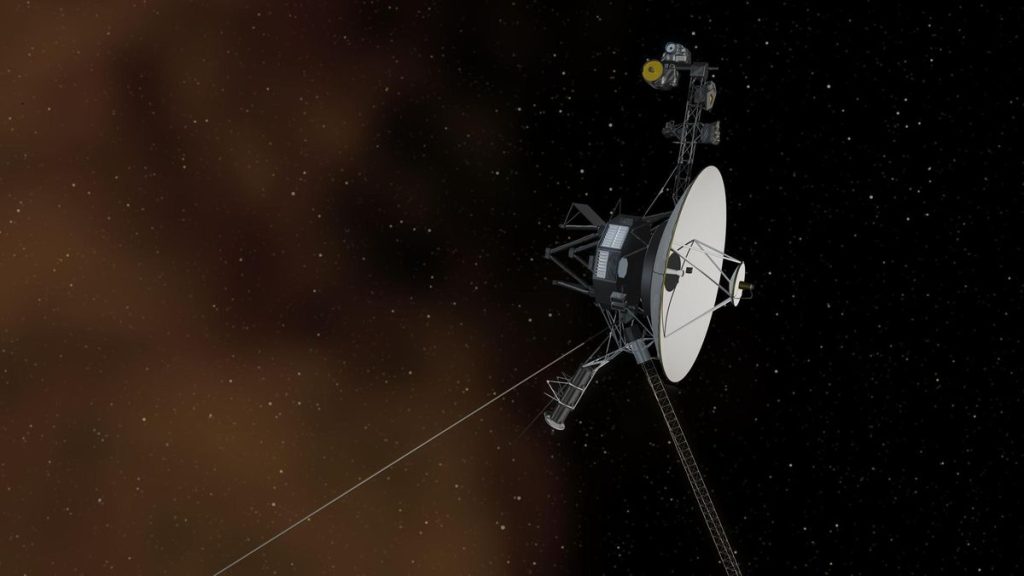
Voyager 1 spacecraft phones home with transmitter that hasn’t been used since 1981 (Image Credit: Space.com)
Following recent communication issues, NASA’s Voyager 1 spacecraft resorted to using a backup radio transmitter that has been inactive since 1981.
The interstellar explorer experienced a brief pause in communications after putting itself in a protective state to conserve power. This was triggered by a command sent on Oct. 16 from NASA’s Deep Space Network (DSN) — a global array of giant radio antennas — instructing the spacecraft to turn on one of its heaters.
The mission’s flight team first realized there was an issue with Voyager 1 on Oct. 18, when the spacecraft failed to respond to that command. The team later discovered that the spacecraft had turned off its primary X-band radio transmitter and instead switched over to its secondary S-band radio transmitter, which uses less power, according to a statement from NASA.
“The transmitter shut-off seems to have been prompted by the spacecraft’s fault protection system, which autonomously responds to onboard issues,” NASA officials said in the statement. “The team is now working to gather information that will help them figure out what happened and return Voyager 1 to normal operations.”
Related: NASA shuts off Voyager 2 science instrument as power dwindles
Voyager 1’s fault protection system can be triggered for a number of reasons, such as if the spacecraft overdraws its power supply. If that happens, the spacecraft will turn off all non-essential systems to conserve power and remain in flight.
After sending instructions to Voyager 1 on Oct. 16, the team expected to receive data back from the spacecraft within a couple of days; it normally takes about 23 hours for a command to travel more than 15 billion miles (24 billion kilometers) to reach the spacecraft in interstellar space, and then another 23 hours for the flight team on Earth to receive a signal back.
However, on Oct. 18, the team was unable to detect Voyager 1’s signal on the X-band frequency that the DSN antennas were listening for. This was because, to use less power, the spacecraft’s fault protection system lowered the rate at which its radio transmitter was sending back data. The flight team was able to locate a signal later that day – but then, on Oct. 19, communication with Voyager 1 stopped entirely when its X-band transmitter was turned off.
The spacecraft’s fault protection system is believed to have been triggered twice more, ultimately causing it to switch to the S-band radio transmitter, which, prior to that date, hadn’t been used since 1981. Given the spacecraft is located much farther away in interstellar space today than it was 43 years ago, the flight team was not sure a signal on the S-band frequency could be detected — especially because it transmits a significantly fainter signal while using less power.
However, the team didn’t want to risk sending another signal to the X-band transmitter and triggering the fault protection system again. So, instead, a command was sent to the S-band transmitter on Oct. 22. Two days later, on Oct. 24, the team was finally able to reconnect with Voyager 1.
Now, the team will investigate what may have triggered the spacecraft’s fault protection system in the first place, given Voyager 1 should have had ample power to operate the heater. However, it may be weeks before operators identify the underlying issue, according to the statement.
Voyager 1, which launched in 1977, ventured into interstellar space in 2012, becoming the first spacecraft to cross the boundary of our solar system. Its time in deep space has taken a toll on its instruments and caused an increasing number of technical issues. Earlier this year, the team had to fix a separate communications glitch that was causing the spacecraft to transmit gibberish.
While spacecraft’s advanced age and distance from Earth can make maintenance challenging, Voyager 1 continues to return vital data from beyond the solar system.





